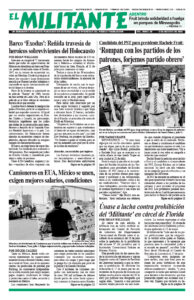While Democrats and the liberal media are heralding a government report saying the average monthly inflation rate is falling, prices on a broad range of essential goods working people need remain stubbornly high, and they’re not coming down. This reality clobbering the working class is disguised by the way average inflation figures weigh both essentials like food, rent and gas, along with extravagances limited to the wealthy, like yachts and Riviera vacations.
Some of the most outrageous costs have to do with the medical “care” industry. Prices for prescription drugs are going through the roof as giant pharmaceutical companies, their subsidiaries and related drug store chains put their drive for profits above all, especially over providing actual health care for millions of working people.
More and more, receiving a cancer diagnosis means falling deeply into debt. Over half of cancer drugs introduced between 2019 and 2023 cost over $200,000 a year.
“Cutting back on meds. Cutting back on doctor visits. Losing your home. Cutting back on food — these are not things that we want to believe happen to people with cancer in this country,” Dr. Reshma Jagsi, a radiation oncologist at Emory University School of Medicine, told the New York Times.
But this is exactly what’s happening. The fact of the matter is the price workers pay to purchase needed prescription drugs is way out of whack with what it costs the pharmaceutical bosses to produce them. That’s because the major health conglomerates — CVS Health, Cigna and UnitedHealth Group — are extorting profits from the pockets of working people through a variety of opaque schemes. These companies handle some 80% of the U.S. prescriptions dispensed to 200 million people.
One not so well-known part of this operation is conducted by so-called drug middlemen companies, known as pharmacy benefit managers — Caremark for CVS, Express Scripts for Cigna, and Optum Rx for UnitedHeath.
These PBMs, as they are known in the industry, supposedly were created to drive down drug costs, a June 21 Times article said. But much of the time they do the exact opposite. “They steer patients toward pricier drugs, charge steep markups on what would otherwise be inexpensive medicines and extract billions in hidden fees.”
In Oklahoma, CVS charged Kent McKinley $138,000 a year for the generic version of Everolimus to treat his gastrointestinal cancer. But the wholesale price for this drug was just $14,000. So the drug company giant pocketed $124,000 in profits.
Similarly, in New Jersey, Express Scripts told Joseph Kaplan, a 77-year-old retiree, he had to pay $211 for a three-month supply of his allergy drug, which he could have gotten for $22 at Costco. “It’s just nuts,” he told the Times.
‘Pricier drugs, steep markups’
Some end up paying even more through this profit swindle. According to a Federal Trade Commission study, pharmacy benefit managers steered patients to their own pharmacies and away from unaffiliated ones. As a result, they would be charged up to 200 times what they would pay for the same drug at Costco.
Another way these profit-gougers force you to stay within their system, the Times explained, “is to not allow patients to receive 90-day supplies of drugs if they fill prescriptions at outside pharmacies.” And if your mail order is delayed or lost, you may not be able to get a replacement.
In many cases pharmacy benefit managers only approve taking more expensive brand name drugs, even when cheaper generics are available. This is the case for drugs to treat Hepatitis C as well as the blood thinner Eliquis, for example.
This swindle — which drives prices up — is helping drive independent drugstores out of business, hitting working people in rural areas the hardest. They must travel farther and face increased difficulties in filling prescriptions and getting other medical supplies.
And big chain drug stores are shuttering underperforming stores nationwide. Walgreens has announced plans to close over 2,000 of its 8,600 stores. CVS, which closed 300 stores in 2021, projects shutting another 900 this year.
Another attack on women’s health and comfort was highlighted this month when the Wall Street Journal reported prices of tampons, pads and other menstrual products have soared, jumping at an even higher rate than food.
Three companies have a virtual monopoly on this $3.5 billion market — Proctor & Gamble, Kimberly-Clark and Edgewell Personal Care. The price of sanitary pads has soared 41% since 2019, while a package of tampons jumped 36%. The reason these companies can corner the market, and largely bar production of generic versions, is that they require government approval as a “medical device.”
The Journal, whose editors now seem to be trending toward more “politically correct” terminology, said the number of “menstruation-age people” in the U.S. is growing. The average age of onset of women’s periods has fallen to 11.9 years old.


